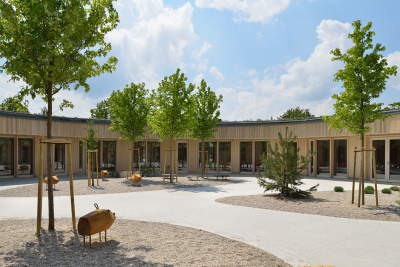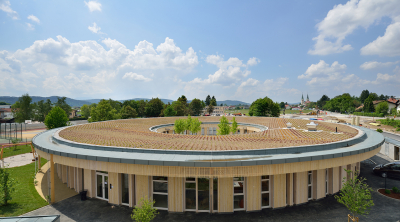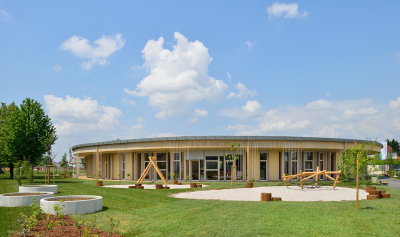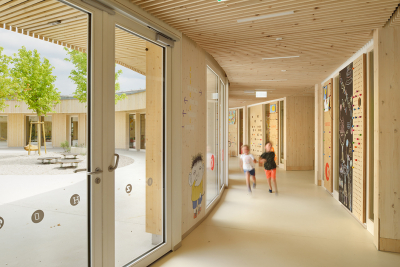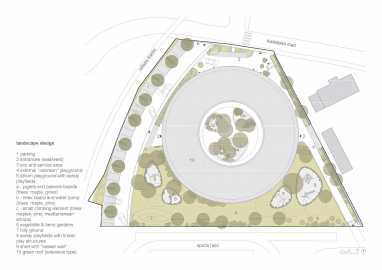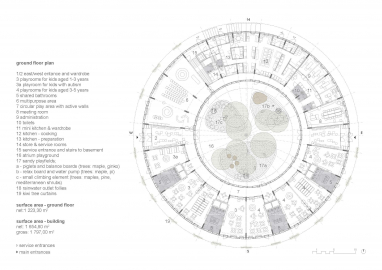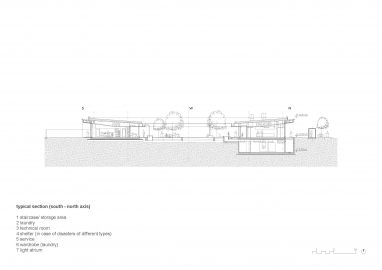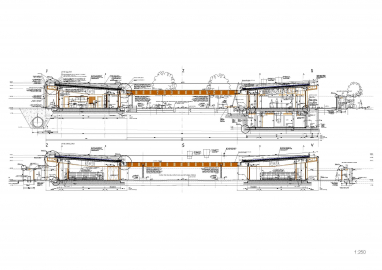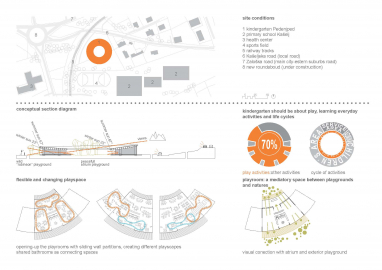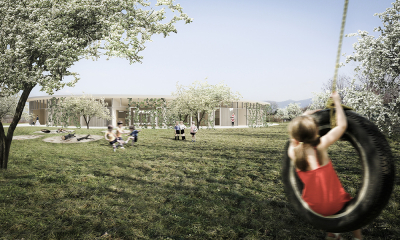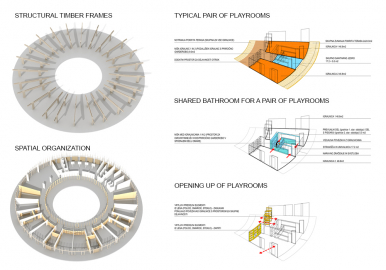Pedenjped Day-Care Centre, Pedenjcarstvo Unit in Ljubljana Kašelj
The kindergarten with an inner atrium playground and external “robinson” one is conceived as the "third teacher". Its circular space encourages children to learn through play, movement and spatial experience. Visually connected playspaces encourage them to observe and take part in the big, unknown world outside and the small, homely one within.
The circular kindergarten with an open-air atrium is an answer to the heavy traffic site and dispersed suburban housing. The atrium is the heart of the building – a safe outdoor playroom, around which all the spaces are positioned. There are eight playrooms (S), sports area (W), administration quarter (E) and service area (N). The rooms are connected with a circular play area with "active didactic walls" – blackboard, abacus, alfabetarium, dots and green walls for plants.
The kindergarten is simultaneously an introverted and extroverted building: all the spaces turn outwards to the "robinson" playground, but maintain a visual connection with the atrium.
An important design feature is the openness of the educational environment – almost all the rooms are partly glazed and visually accessible to children and educators. This encourages children to understand nature and life, including everyday tasks such as cooking, cleaning, gardening etc.
The playrooms are organized in pairs, sharing a bathroom in the middle. Some playrooms have sliding walls between them, which allow for enlargement of play area and socialization of children from different groups.
The project won an open competition in 2013. Its main challenge was to overcome rigid Slovenian kindergarten spatial regulations, built upon closed playspaces and division of activities. Another challenge was an introduction of a rather experimental kindergarten typology. The actual kindergarten is a step towards the more open and flexible educational environment, a soft transition from a playroom to playspace, adapted to our context – behavioral characteristics of children and pedagogical methods. The "role models" were entirely open kindergarten in Tokyo (Tezuka architects) and a soft shell like Vetrnica kindergarten in Ljubljana (Stanko Kristl architect).
Yet another challenge was control of visual connections in order to avoid the "panopticum effect". Disposition of glazed parts of playrooms and other spaces allow the views as well as privacy of users.
The last challenge was the low energy consumption paradigm – despite in-built technology, the design builds upon climate responsiveness: disposition of rooms according to orientation, natural ventilation, passive heating through glazing, cooling with generous overhangs, greenery and green roof.
The kindergarten is built in timber that forms the structure, facade and furniture. The basement with shelter, technical rooms and laundry is in concrete.
Timber was chosen as a sustainable natural material with warm tactile feeling, despite its higher price. As kindergarten is a public educational building for children, the priority was given to ecology.
The basic structural element is simple and radially repeating: laminated timber frame, composed of two pillars and a beam, covered with a CLT roof slab.
The beams are cantilevered at their ends and designed as generous overhangs: they give shadow in summers and protect from rain.
The façade of the inner atrium is set eccentrically in order to create a wider overhang in the sunnier part and simultaneously create a wider circular play area in front of playrooms. The green sedum roofing contributes to the pleasant climate in the interior and exterior of the kindergarten.
The microclimate will improve through time, with the growth of vegetation in the atrium and "robinson playground" and kiwi tree curtains, planted around perimeter of the building.
The building is low energy building, high B1 class.

